| |
|
St Mary,
Middleton
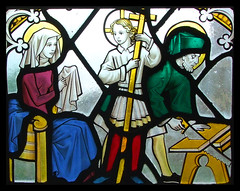 |
|
A
big, rugged church, entirely in the East Anglian
style, although the carstone it is built from may
be unfamiliar to those who don't know west
Norfolk. Mortlock says that it has the
imperishable look of something that will not be
moved, and that is about right, not even by
the busy traffic on the A47 which forms the main
road through the village. I had been told that I
wouldn't find Middleton church very interesting,
but that was not the case at all, and even more
than this I was delighted to find it open in an
area where churches tend to be locked with a
keyholder notice at best. I am assured that
Middleton church is open every day. This was a
busy place in the late medieval period, with
plenty of money, probably as a consequence of its
place on the only road between Norfolk and the
Midlands. Churches around here did not tend to
experience major rebuilds, but this one did, and
everything we see, pretty much, is 15th Century
or 19th Century restoration. Only the chancel is
earlier, a happy accident with the Early English
tracery providing a sense of mystery after the
clear, rational Perpendicular of the nave and
aisles. Actually, the chancel windows only date
from the 1862 restoration, but they replicate
what was there before and it is pleasing that the
chancel wasn't wiped out and replaced by
something grand and triumphalist.
|
I came
here on an overcast morning of drizzle, and this didn't
help the interior much. It was a bit like stepping into a
fairly gloomy barn, the only spots of colour being a
couple of windows which I will come back to in a moment,
and the view east to the chancel. However, wandering down
the nave a bit, the overwhelming impression is one of
height, and the reason for this is obvious when you face
west and see that narrow and enormous tower arch shooting
up to heaven. Those Perpendicular masons knew what they
were doing. In the other direction, the chancel arch is
equally enormous, the chancel appearing almost as a small
afterthought beyond.
Most of
the nave windows are clear, but two have excellent
windows of the 1930s by the Powell & Sons workshop.
One depicts the Adoration of the Magi and the other the
Finding of the Young Christ in the Temple. They are in
that early-16th Century style unfamiliar in English
churches but seen at its best in Kings College Chapel in
Cambridge - busy scenes, everybody doing something and
giving a sense of bustle. It would be interesting to know
who the artist was.
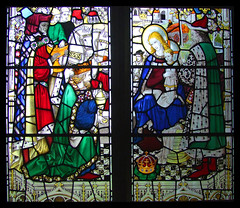 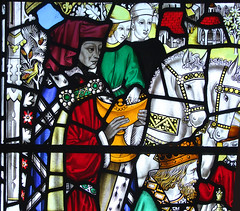 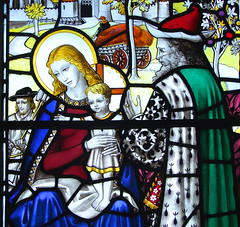
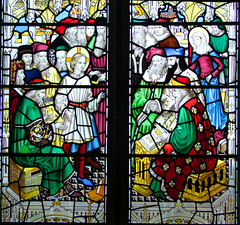 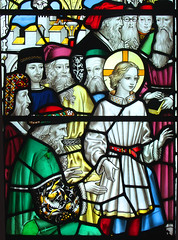 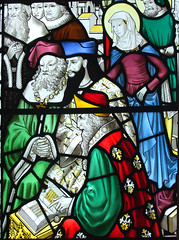
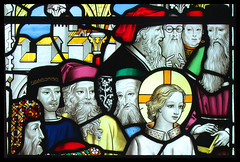 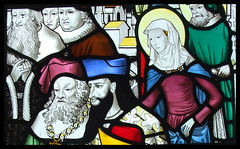
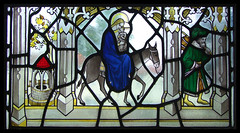 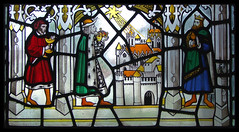
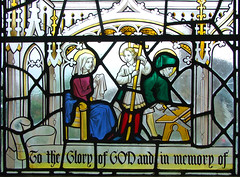 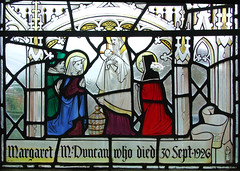
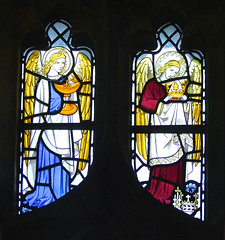 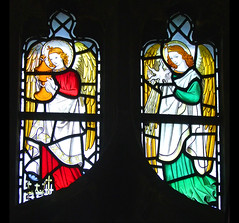 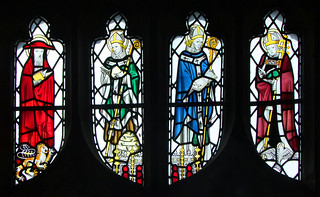
At first
sight the two windows seem oddly placed, one in the north
aisle and the other in the south but not facing each
other. But if you count the clear windows, you can tell
that they were probably originally intended as part of a
sequence which would have started with the Annunciation
in the north-west corner and may have finished with the
Baptism of Christ at the east end of the south aisle. A
grand scheme it would have been, but the fact that the
two existing windows are almost contemporary with each
other suggests a change of plan. It is tempting to
imagine a Trollopeian controversy, but most likely it was
that the Thirties depression and then the Second World
War intervened.
St Mary is
the only church in East Anglia with furnishings by Robert
Thompson, the Yorkshire-based 'mouseman'. You'll find his
signature mouse carved on the base of the lectern, and
the communion rails and prayer desk are also his. Their
clean Arts and Crafts lines may lull you into a false
sense of simplicity, for as you step into the chancel
you'll be struck by the riot of gold of the organ. In
itself not terribly exciting, but the screen that hides
the blower is made up of part of one side of the old rood
screen, and still retains its Saints, albeit garishly
repainted. They are St Jude, St James, St Philip and St
Thomas. The chancel arch would have been wide enough for
twelve Apostles, six each side. It may be that these
panels did not come from this church originally, but if
they did, I wonder what happened to the rest?
| Outside
in the churchyard, to the south of the chancel, a
headstone depicts the story of Abraham and Isaac,
Isaac bound on an altar and his father lifting
the knife to kill him, the angel intervening and
offering Abraham a ram caught in a thicket to
sacrifice instead of his son. This is not a
common subject - off the top of my head I have
seen it elsewhere on headstones at Soham and St
Ives, both in Cambridgeshire - but what makes
this one particularly unusual is that there are
two figures in 19th Century dress in the bottom
corner, one walking with a stick behind a donkey
and the other sitting above him on a hillock,
apparently reading a book. They appear quite
unconcerned by the angel appearing in a cloud
above their heads. Middleton is one of the few
place names to appear in Norfolk, Suffolk and
Essex. Perhaps not surprising, as it is one of
the most common placenames in England.
|
|
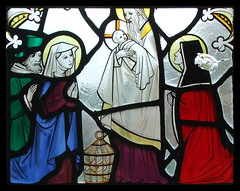 |
|
|
|
